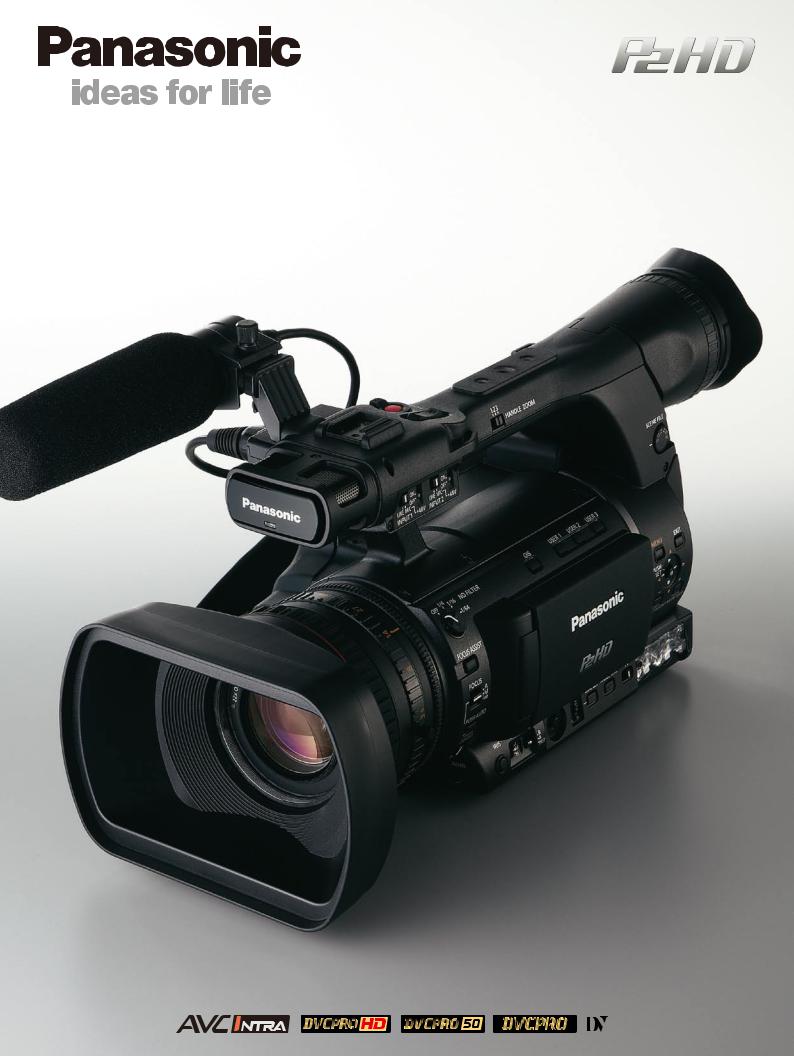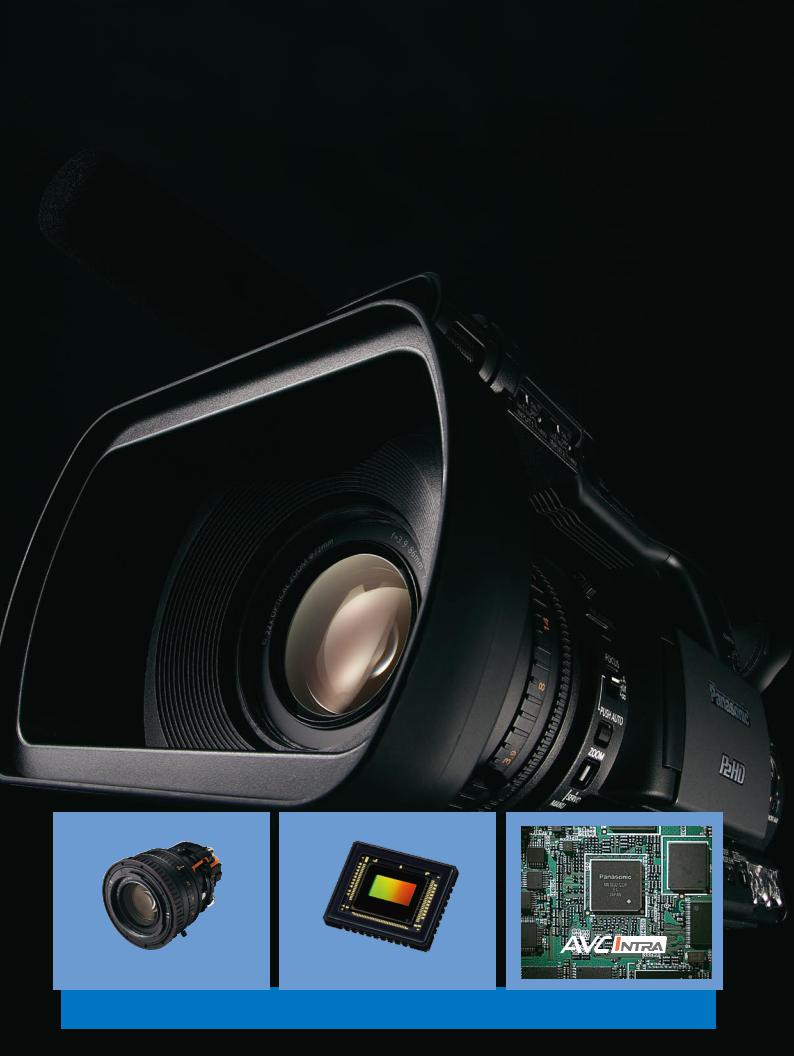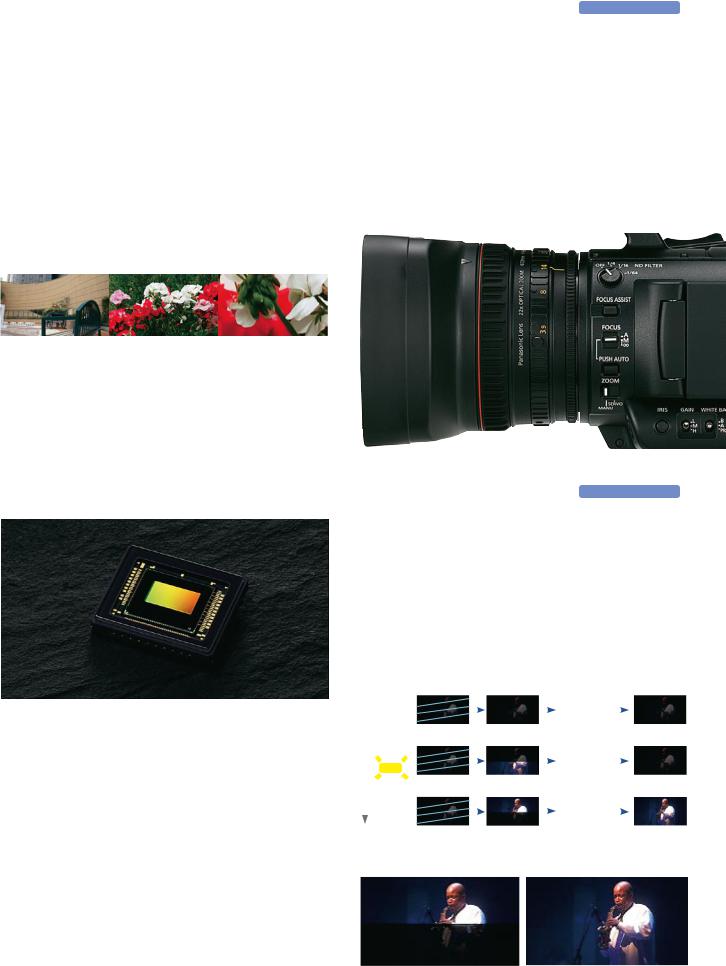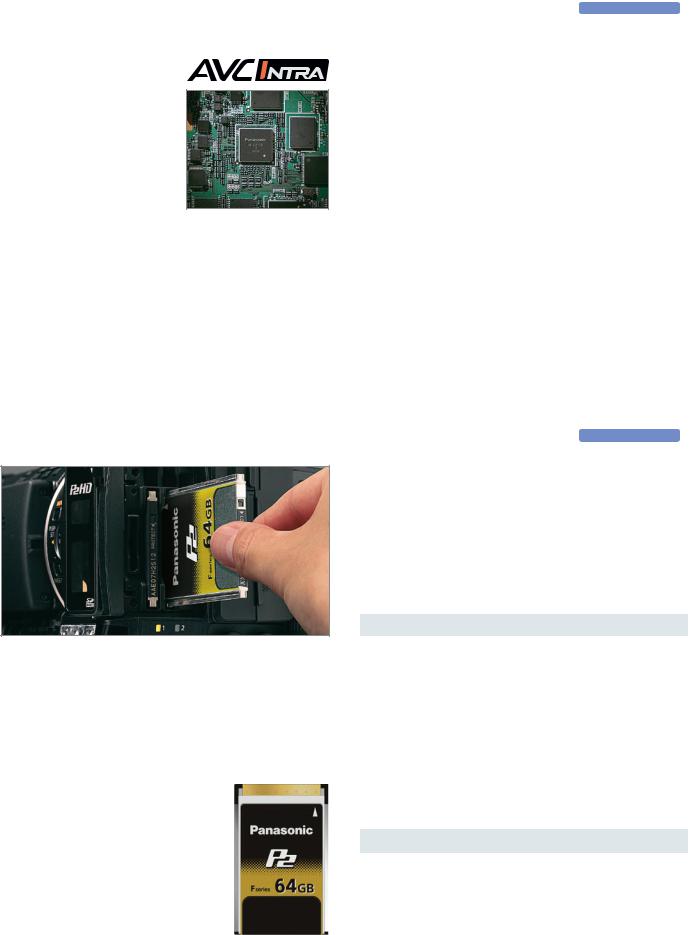Panasonic AG-HPX250, AG-HPX255 User Manual

AG-HPX255
AG-HPX250
P2 Handheld Memory Card Camera Recorder
(AG-HPX255P/HPX250P, AG-HPX255EJ/HPX250EJ, AG-HPX255EN/HPX250EN)

Shoulder-Type Performance and Functions in a Handheld Camera Recorder for Broadcast Use
The high-performance AG-HPX255/HPX250 P2 handheld camera recorders fill out the P2HD Series by incorporating the newest technologies throughout — in the lens, camera and recorder sections. The newly developed 22x zoom lens covers a wide shooting range, from wide-angle to telephoto, and features three manual rings for precise control. Imaging is optimized by the high-sensitivity, low-noise 1/3-type 2.2-megapixel U.L.T. (Ultra Luminance Technology) 3MOS image sensors. And the AG-HPX250/HPX255 are the first handheld models to support AVC-Intra codecs. This combination produces a level of performance that rivals many full-size shoulder-type camera recorders, and adds the high-quality acquisition of Full-HD (1920 x 1080) in 10 bit, 4:2:2 full sampling. Image expression is also boosted by the Variable Frame Rate (VFR) function, and system expansion for broadcasting and other production applications is provided by multi-camera synchronizing. The stylish design of the AG-HPX250/HPX255 adds further to both mobility and operating ease, and opens a new stage for news gathering and image acquisition. In addition to these specifications, the AG-HPX255 is fully prepared for broadcast use, including camera remote capabilities when combined with the optional AG-EC4G Extension Control Unit.
28 mm to 616 mm*, 22x Zoom Lens |
|
2.2-Megapixel U.L.T. Image Sensors |
|
1920 × 1080 10 bit 4:2:2 AVC-Intra Codec |
|
|
|
|
|
*35 mm equivalent
Full HD (1920 x 1080 Pixels) & 10 bit 4:2:2 Full Sampling Recording
1

22x Panasonic Lens — Zooming in on New Levels of Image Expression |
|
|
|
|
|
|
|
|
|
|
AG-HPX255/HPX250 |
|
|
|
|
|
|
|
|
Packed with Panasonic Optical Technology
The high-performance zoom lens was developed specifically for professional HD video production. While inheriting the wide-angle capabilities of the DVX and HVX Series, it adds the same level of operating ease as you'd expect from an interchangeable lens model for broadcasting and other professional uses. Combining 18 lens elements in 12 groups, this advanced lens unit further adds a UHR (Ultra High Refractive) glass element, a low dispersion element and aspherical lenses. This newest optical technology can provide high resolution.
In addition, it is combined with a unique Panasonic digital signal processing technology called Chromatic Aberration Compensation (CAC) to minimize color bleeding in the surrounding image and achieve rich expression with finely rendered nuances and excellent shading. Zooming from 28mm to 616mm (35mm equivalent), this 22x zoom lens covers a wide field of view, from wide-angle to telephoto, without a conversion lens.
|
|
|
Wide 28 mm |
Tele 616 mm (22x) |
22x optical zoom x |
|
|
10x digital zoom (220x) |
Three Manual Rings — Zoom, Focus and Iris
The lens unit is provided with three rings — a mechanical (cam-driven) zoom ring, a focus ring, and an iris ring. You can operate them manually almost like an interchangeable lens including rugged operation of zoom ring.
Optical Image Stabilizer, Digital Zoom, and ND Filter
•Hand-shake correction with the Optical Image Stabilizer (OIS).
•Digital Zoom function.* It can be assigned to an user button and close up to 2x, 5x, and 10x. In combination with the optical zoom, this function provides a telephoto capability up to 220x.
•Four-position (OFF, 1/4 ND, 1/16 ND, 1/64 ND) optical neutral density filter wheel.
* The digital zoom cannot be used while operating the Dynamic Range Stretch (DRS) or Scan Reverse functions. If either function is operated while digital zooming, the zoom will be automatically turned off.
Also, Flash Band Compensation (FBC) will not operate while digital zooming.
Focus Ring |
|
|
|
|
Zoom Ring |
|
|
|
|
|
Iris Ring |
|
|
|
|
|
|
High-Sensitivity, Low-Noise U.L.T. Image Sensor |
|
|
|
|
|
|
|
|
|
|
AG-HPX255/HPX250 |
|
|
|
|
|
|
|
|
U.L.T. image sensor
High-Sensitivity F10*, 2.2-Megapixel, Low-Noise U.L.T. Image Sensor and Optimized Signal Processing Circuit
The AG-HPX255/HPX250 feature the Ultra Luminance Technology (U.L.T.) 1/3-type 2.2-megapixel 3MOS image sensor that is incorporated in our shoulder-type P2HD camera recorders. This advanced image sensor is set to maximize the performance of the lens and signal processing circuit under standard shooting conditions. Progressive Advanced Processing (PAP) technology, which is driven by 3D adaptive processing, has also been further refined to enable high-sensitivity F10*, low-noise shooting in dimly lit places.
*AG-HPX255/HPX250 sensitivity is selectable, F10 is PAP Filter Type1 and F7 is PAP Filter Type2 in 59.94Hz mode.
In 50Hz mode, F11 is PAP Filter Type1 and F8 is PAP Filter Type2. The default setting is PAP Filter Type2.
Flash Band Compensation
In contrast with the CCD image sensor, which accumulates still images of single frames that are exposed with identical timing, the MOS image sensor uses a rolling shutter system that sequentially scans each line of
pixels. This lowers power consumption and enables high-speed drive, but because the exposure timing differs for each line, when an external flash is used, it tends to produce images where the brightness is divided between the top and bottom of the image. This is called the flash band effect. The AG-HPX255/HPX250 are equipped with highly accurate flash band detection and compensation software. By generating pairs of frames containing flash bands, and frames in which a flash extends from the previous frame to the entire screen, and then using the compensation process to adjust the level, the flash band effect of
MOS-based imagers is eliminated.
|
|
|
|
|
|
|
|
MOS |
|
|
Output |
|
|
|
|
|
After |
|
|
|
|
|
|
|
|
|
Image Sensor |
|
|
Image |
|
|
|
|
|
Compensation |
|
|
|
|
|
|
|
|
|
|
|
|
|
|
|
|
|
|
|
|
|
|
|
|
|
|
|
|
|
|
|
|
|
|
|
|
|
|
|
|
|
|
|
|
|
|
|
|
|
|
|
|
|
|
|
|
|
|
|
|
|
|
|
|
|
|
|
|
|
|
|
|
|
|
|
|
|
|
|
|
|
|
|
|
|
|
|
1 |
|
|
|
1 |
||||
|
|
|
|
|
|
|
|
|
|
|
|
|
|
|
Flash Band |
|
|
|
|
|
|
|
|
|
|
|
|
|
|
|
|
|
|
Compensation |
|
|
|
|
|
|
Flash |
|
|
|
|
|
|
|
|
|
|
|
|
|||
|
|
|
|
|
|
|
|
|
|
|
|
Process |
|
|
|
|||
|
|
|
|
|
|
|
|
|
|
|
|
|
|
|
|
|
|
|
|
|
|
|
|
|
|
|
|
|
2 |
|
|
2 |
|||||
|
|
|
|
|
|
|
|
|
|
|
|
|
||||||
|
|
|
|
|
|
|
|
|
|
|
|
|
|
|
|
|
|
|
|
|
|
|
|
|
|
|
|
|
|
|
|
|
|
|
|
|
|
|
|
|
|
|
|
|
|
|
|
|
|
|
|
|
|
|
|
|
|
|
|
|
|
|
|
|
|
|
|
|
|
|
|||||
|
|
|
|
|
|
|
|
|
|
|
|
|
|
|
|
|
|
|
Time Flow |
3 |
|
|
|
3 |
|||||||||||||
MOS Output Imager |
After Compensation Imager |
2

The High-Quality DSP Matches Image Processing and Quality to match Each Shooting Situation |
|
|
|
|
|
|
|
|
|
|
AG-HPX255/HPX250 |
|
|
|
|
|
|
|
|
20 bit Digital Signal Processor
The AG-HPX255/HPX250 incorporate a high-performance 20 bit DSP that handles image rendering processes such as gamma
and various detail enhancement DSP Processor functions with exceptional
precision.
Dynamic Range Stretch (DRS)
In scenes with mixed contrast, such as when panning from indoors to outdoors, the DRS function automatically suppresses blocked shadows and blown highlights. A gamma curve and knee slope are estimated to match the contrast of each pixel, and applied in real time. When dark, bright, and intermediate shades are all contained in the same scene, this produces excellent gradation for each shade and minimizes blocked shadows and blown highlights.
* The DRS function does not operate in 1080/24p, 1080/25p or 1080/30p mode.
|
|
|
DRS OFF |
|
DRS ON |
Seven Mode Gamma for Richer Gradation
|
|
|
|
|
HD NORM mode |
CINE-LIKE D mode |
|||
AG-HPX255/HPX250 Gamma Modes |
|
|||
|
|
|
|
|
HD NORM: |
Suitable for standard HD recording. |
|
||
|
|
|
|
|
LOW: |
Works to flatten out a high contrast scene. |
|||
|
|
|
|
|
SD NORM: |
Normal setting for SD. |
|
||
|
|
|
|
|
HIGH: |
Expands the tone of dark parts and makes a brighter image. |
|||
|
The contrast softens. |
|
||
|
|
|
|
|
B.PRESS: |
Makes the contrast sharper than LOW. |
|||
|
|
|
|
|
CINE-LIKE D: |
The Cine-Like mode shifted to prioritize dynamic range. |
|||
|
|
|
|
|
CINE-LIKE V: |
The Cine-Like mode shifted to prioritize contrast. |
|||
|
|
|
|
|
Other Camera Image Settings
•Variable shutter speed from 1/6 to 1/2000 sec. plus
Synchro Scan function.
•Matrix setting including a Cine-Like mode
•Adjustable H detail level, V detail level, detail coring and skin tone detail.
•Adjustable chroma level, chroma phase, color temp and master pedestal.
•Knee point settings: Auto, Low, Mid and High.
Drawing on technologies developed for the VariCam, Panasonic has equipped the AG-HPX255/HPX250 with advanced gamma functions that address seven different shooting scenarios, including two
Cine-Like Gammas.
Rapid Response with Agile Shooting Assist Functions |
|
|
|
|
|
|
|
|
|
|
AG-HPX255/HPX250 |
|
|
|
|
|
|
|
|
Advanced Focus Assist Functions
A variety of focus assist functions support quick and accurate focusing in
Manual Focus mode.
•Turbo-Speed One-Push Auto-Focus: Pressing the PUSH AUTO button enables focusing in 0.5 sec. or less.*1 *2
•Focus-In-Red Display: This function emphasizes the image areas in focus by marking the edges in red.*2
•Expand: Enlarging the center portion increases visibility.
•Focus Bar: This provides a graphical meter display of the focus level.
*1: Focusing time may vary depending on the shooting conditions and object.
*2: You may need to update the AG-HPX250 firmware. Please refer to "Service and Support" on the Panasonic Website (http://pro-av.panasonic.net/).
|
|
|
Focus Assist OFF |
|
Focus Assist ON |
Three Position Gain Selector plus 30dB Super Gain Function
There is a three position gain selector, with L, M and H settings. To each setting you can assign a gain value from 0, +3, +6, +9, +12, +15 and
+18 dB. There is also a Super Gain such as +24 dB and +30 dB.
Scene File / User File
Set Scene dial for an instant set of shooting conditions. Six preset files are provided, and you can change any of the six file names and their settings as desired. One set can be stored internally in the AG-HPX255/ HPX250, and four sets on an SD Memory Card. One file with camera setting values can also be stored internally, and four files on an SD
Memory Card.
Scene File Description
F1: — |
Standard settings |
|
|
F2: FLUO. |
Indoor shooting under fluorescent lights |
|
|
F3: SPARK |
Highlighting subjects at receptions, events etc. |
|
|
F4: B-STR |
Enhanced gradations of luminance in low light scenes |
|
|
F5: CINE V |
Cine-Like setting shifted to prioritize contrast* |
|
|
F6: CINE D |
Cine-Like setting shifted to prioritize dynamic range* |
* Selecting a scene file does not change the video recording format. If you want to switch to 25p, 24p and 30p, you must do so as a separate procedure.
Five User Buttons
There are a total of five User buttons: User Main, User 1 to 3 on the top panel, and User 4 on the rear of the AG-HPX255/HPX250. Based on user's requirements, customized operation can be set by assigned 18 versatile functions to these user buttons.
User button allotment function
SPOTLIGHT, BACKLIGHT, ATW, ATW LOCK, S.GAIN, D.ZOOM, Y GET, DRS, TEXT MEMO, SLOT SEL, SHOT MARK, MAG A. LVL, LVL METER, PRE REC, WFM, LAST CLIP, FBC, LCD B.L.
3

Exclusive P2HD High Image Quality: 10 bit, 4:2:2, AVC-Intra 100 Codec |
|
|
|
|
|
|
|
|
|
|
AG-HPX255/HPX250 |
|
|
|
|
|
|
|
|
Full-Pixel, Full-Sample AVC-Intra Recording
These are the first handheld camerarecorders to support the AVC-Intra codecs of the P2HD Series for HD recording of broadcast and movie images. Featuring a high compression ratio based on the new MPEG-4 AVC/ H.264 moving picture compression technology, this advanced system maintains intra-frame compression to provide both high image quality and excellent editing performance.
It offers recording and playback of
both AVC-Intra 100 and AVC-Intra 50 modes, and also supports
DVCPRO HD recording and playback.
•AVC-Intra 100: 1920 x 1080,* 10 bit, 4:2:2
High-quality images with full-pixel HD and full sampling are recorded at the same bit rate as DVCPRO HD, bringing agile mobility to high-end production.
•AVC-Intra 50: 1440 x 1080,* 10 bit, 4:2:0
Image quality is the same level as DVCPRO HD, but with the SD (DVCPRO 50) bit rate. You get twice the recording time of DVCPRO HD, and about half the required data transmission time.
* These figures are for 1080i/p mode. The AG-HPX255/HPX250 also supports 720p mode.
Multi-Format Recording with Native 24p/25p Support and More
•Native recording modes: In addition to 1080/59.94i with the AVC-Intra codec, native recording is supported at 1080/23.98p or 1080/29.97p and 1080/25p. In 720p, native recording is possible for both DVCPRO HD and
AVC-Intra, making it possible to extend recording time by 2 to 2.5 times in comparison with pull-down recording.
*Camera through output and playback image output are pulled-down 59.94 (50) frames.
•Pulldown record mode: This VariCam-compatible mode records*1 with the DVCPRO HD codec. A 2:3 pulldown is applied to 23.98p, and a 2:2 pulldown is applied to 29.97p, to record 1080/59.94i or 720/59.94p and 1080/25p over 50i or 720/25p over 50p. The 23.98pA (2:3:3:2 advanced pulldown) mode is also supported, allowing editing on applicable nonlinear systems*2 with little image degradation.
•59.94Hz/50Hz selector: Supports worldwide HD/SD production. •SD image acquisition: The DVCPRO 50/DVCPRO/DV multi-codec
enables 480/576 image acquisition, with aspect ratio conversion. Select from Side Crop, Letter Box and Squeeze modes.
*1: Not compatible with the AVC-Intra codecs.
*2: See the following website for details on applicable systems. http://pro-av.panasonic.net/en/sales_o/p2comp/index.html
High Quality/16 bit, Four Channel Digital Audio
The AG-HPX255/HPX250 can record high quality/16 bit digital audio on all four channels. You can freely select the audio source for each channel, choosing from built-in mic, external mic and line-in. Level volume is also supported on all four channels.
P2 Card Recording Boasts High Reliability and Easy Operation |
|
|
|
|
|
|
|
|
|
|
AG-HPX255/HPX250 |
|
|
|
|
|
|
|
|
Double Slot System with Two P2 Card Slots
In addition to allowing continuous recording onto two P2 cards, this system offers the following functions.
•Card select: The recording slot can be switched in Standby mode.
•Hot-swap recording: The card in the standby slot can be exchanged
while the other card is being recorded on.
P2 Card Recording Offers High Reliability and a Proven Record for Broadcasting
The P2 card was originally developed for broadcast use. In addition to its large 64 GB* capacity, it strongly resists impacts, vibration and temperature changes, and withstands repeated recording and initialization cycles for extended recording use. The card connector section is designed specifically for professional use, resulting in extremely high durability for insertion and removal. The P2 card and P2HD Series are widely used in broadcast and movie production studios and have a proven track record for reliability, durability and easy operation.
*Total card capacity includes space for data management such as system data; therefore, the actual usable area is less than the capacity indicated on the card.
Versatile MXF File-Based Recording
File-based recording onto memory cards enables high-speed starts, recording starts with no need for cueing, and protection against accidental data overwriting. The recorded data is organized into MXF files. The files can be transferred to a nonlinear editor or over a network without the need for digitizing.*
*PCs must be installed with the included P2 driver in order to mount P2 cards. For editing, PCs must be installed with P2-compatible editing software available from various companies. Read "Notes Regarding the Handling of P2 Files Using a PC" on the back page.
AG-HPX255/HPX250 Recording Format & Recording Time
HD Format |
Pull |
Codec & Recording Time (with two 64 GB P2 Card) |
|
||
down |
DVCPRO HD |
AVC-Intra 100 |
AVC-Intra 50 |
|
|
|
|
||||
1080/59.94i |
— |
|
Approx. 128 min. |
Approx. 256 min. |
|
1080/29.97p over 59.94i |
2-2 |
Approx. 128 min. |
— |
— |
|
1080/23.98p over 59.94i |
2-3 |
— |
— |
|
|
|
|
||||
1080/23.98pA over 59.94i |
2-3-3-2 |
|
— |
— |
|
1080/29.97pN (Native)*1 |
— |
— |
Approx. 128 min. |
Approx. 256 min. |
|
1080/23.98pN (Native)*1 |
— |
— |
Approx. 160 min. |
Approx. 320 min. |
|
1080/50i |
— |
Approx. 128 min. |
Approx. 128 min. |
Approx. 256 min. |
|
1080/25p (over 50i) |
— |
— |
— |
|
|
|
|
||||
1080/25pN (Native)*1 |
— |
— |
Approx. 128 min. |
Approx. 256 min. |
|
720/59.94p |
— |
|
Approx. 128 min. |
Approx. 256 min. |
|
720/50p |
— |
Approx.128 min. |
Approx. 128 min. |
Approx. 256 min. |
|
720/29.97p over 59.94p*2 |
2-2 |
— |
— |
|
|
720/25p over 50p*3 |
2-2 |
|
— |
— |
|
720/23.98p over 59.94p*2 |
2-3 |
|
— |
— |
|
720/29.97pN (Native)*1 |
— |
Approx. 256 min. |
Approx. 256 min. |
Approx. 512 min. |
|
720/25pN (Native)*1 |
— |
|
|||
720/23.98pN (Native)*1 |
— |
Approx. 320 min. |
Approx. 320 min. |
Approx. 640 min. |
|
SD Format |
Pull |
Codec & Recording Time (with two 64 GB P2 Card) |
|
||
down |
DVCPRO 50 |
DVCPRO |
DV |
|
|
|
|
||||
480/59.94i |
— |
|
|
|
|
480/29.97p over 59.94i |
2-2 |
Approx. 256 min. |
Approx. 512 min. |
Approx.512 min. |
|
480/23.98p over 59.94i |
2-3 |
|
|||
|
|
|
|
||
480/23.98pA over 59.94i |
2-3-3-2 |
|
|
|
|
576/50i |
— |
Approx. 256 min. |
Approx. 512 min. |
Approx. 512 min. |
|
576/25p (over 50i) |
2-2 |
|
|||
|
|
|
|
||
*1: Native modes record only the effective frames.
*2: When you select 24 FRAME/30 FRAME in VFR mode in DVCPRO HD 59.94p mode. *3: When you select 25 FRAME in VFR mode in DVCPRO HD 50p mode.
4
